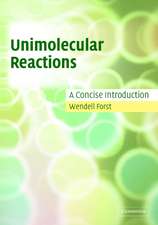Accurate Condensed-Phase Quantum Chemistry: Computation in Chemistry
Editat de Fred Manbyen Limba Engleză Paperback – 10 sep 2018
Accurate Condensed-Phase Quantum Chemistry addresses these new methods and the problems to which they can be applied. The book begins with an overview of periodic treatments of electron correlation, with an emphasis on the algorithmic features responsible for their computational efficiency. The first section of the book:
- Describes the Laplace-transform approach to periodic second-order perturbation theory (MP2)
- Examines local and density fitted schemes for MP2 in crystalline systems
- Presents test calculations for a variety of systems with small and medium-sized unit cells
- Explores the incremental many-body scheme for electron correlation in solids, and describes progress towards metals and molecules on surfaces
- Describes the hierarchical method as an alternative fragment-based approach to electron correlation in crystalline solids, using conventional molecular electronic structure methods
- Examines electrostatically embedded many-body expansion for large systems, with an emphasis on molecular clusters and molecular liquids
- Explores delocalized and localized orbital approaches to the electronic structures of periodic and non-periodic solids
| Toate formatele și edițiile | Preț | Express |
|---|---|---|
| Paperback (1) | 489.26 lei 6-8 săpt. | |
| CRC Press – 10 sep 2018 | 489.26 lei 6-8 săpt. | |
| Hardback (1) | 1000.27 lei 6-8 săpt. | |
| CRC Press – 2 aug 2010 | 1000.27 lei 6-8 săpt. |
Preț: 489.26 lei
Preț vechi: 575.60 lei
-15% Nou
Puncte Express: 734
Preț estimativ în valută:
93.62€ • 100.11$ • 78.06£
93.62€ • 100.11$ • 78.06£
Carte tipărită la comandă
Livrare economică 18 aprilie-02 mai
Preluare comenzi: 021 569.72.76
Specificații
ISBN-13: 9781138374140
ISBN-10: 1138374148
Pagini: 220
Ilustrații: 43
Dimensiuni: 156 x 234 x 12 mm
Greutate: 0.45 kg
Ediția:1
Editura: CRC Press
Colecția CRC Press
Seria Computation in Chemistry
Locul publicării:Boca Raton, United States
ISBN-10: 1138374148
Pagini: 220
Ilustrații: 43
Dimensiuni: 156 x 234 x 12 mm
Greutate: 0.45 kg
Ediția:1
Editura: CRC Press
Colecția CRC Press
Seria Computation in Chemistry
Locul publicării:Boca Raton, United States
Cuprins
Laplace transform second-order Møller-Plesset methods in the atomic orbital basis for periodic systems. Density fitting for correlated calculations in periodic systems. The method of increments—a wavefunction-based correlation method for extended systems. The hierarchical scheme for electron correlation in crystalline solids. Electrostatically embedded many-body expansion for large systems. Electron correlation in solids: delocalized and localized orbital approaches. Ab-initio Monte-Carlo simulations of liquid water.
Notă biografică
Frederick R. Manby is a Reader in the Centre for Computational Chemistry in the School of Chemistry at the University of Bristol, and was previously a Royal Society University Research Fellow. His research has focused on two main areas: first, on the development of efficient and accurate electronic structure methods for large molecules. Second, he has worked on the accurate treatment of condensed-phase systems, including electron correlation in crystalline solids, and on the application of wavefunction-based electronic structure theories to molecular liquids, particularly water. Dr. Manby was awarded the Annual Medal of the International Academy of Quantum Molecular Sciences (2007) and the Marlow Medal of the Royal Society of Chemistry (2006) in recognition of his research on molecular electronic structure theory.
Descriere
The theoretical methods of quantum chemistry have matured to the point that accurate predictions can be made and experiments can be understood for a wide range of important gas-phase phenomena. A large part of this success can be attributed to the maturation of hierarchies of approximation, which allow one to approach very high accuracy, provided that sufficient computational resources are available. Until recently, these hierarchies have not been available in condensed-phase chemistry, but recent advances in the field have now led to a group of methods that are capable of reaching this goal. This book addresses these new methods and the problems to which they can be applied.











